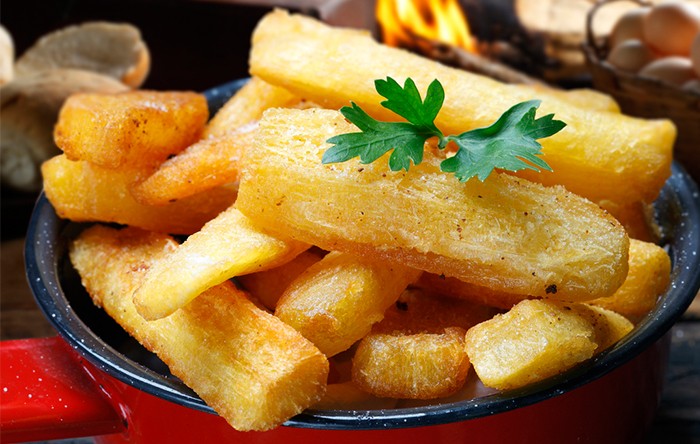Cassava is a valuable source of food for developing countries, but it contains highly toxic cyanide compounds and antinutrients. Therefore, reducing its toxicity and improving its nutritional value is crucial.

Overview
Cyanogens are found in 3 forms in cassava: cyanogenic glucoside (95% linamarin and 5% lotaustratin), cyanohydrins, and free cyanide. Different processing techniques exist to remove cyanogens and their effectiveness depends on the processing steps and the sequence utilized, and it often is time‐dependent. Now let go through all of the main processing methods used worldwide.
Boiling
As the most common way, just boiling is not an effective method for cyanide removal (50%). The inefficiency of this processing method is due to the high temperatures. At 100 °C, linamarin can not then be hydrolyzed into cyanohydrin. Report conducted that the bound glucosides were reduced to 45% to 50% after 25 min of boiling. Free cyanide and cyanohydrin in boiled cassava roots are found at very low concentrations.
However, using small‐sized cassava pieces or increasing the volume of water in which cassava roots are boiled can increase the efficiency of the boiling method. For example by reducing cassava chip size, for instance boiling 2‐ and 50‐g pieces of cassava root for 30 min resulted in a 75% and 25% reduction in cyanide content, respectively. Similarly, by increasing the volume of water from 1‐ to 5‐fold, cyanogen retention was reduced from 70% to 24%.
Steaming, baking, and frying
The loss of cyanide resulting from steaming, baking, or frying is small due to processing temperatures of over 100 °C and to the stability of linamarin in neutral or weak acid conditions. These methods are only suitable for sweet cassava, common in the South Pacific, because they contain low cyanide content.
Drying methods
Two kinds of drying are used for cassava: mechanical drying, such as in an oven, and natural drying by the sun . In the drying process, endogeneous linamarase controls the cyanogenic glucoside removal, and thus is responsible for cyanohydrin and free cyanide accumulation in dried cassava.
During oven‐drying, an increase in drying temperature is accompanied by an increase in cyanide retention. Indeed, the cyanide has reduced around 29% at 46 °C and 10% at 80 °C. In 10‐mm‐thick chips, scientist observed similar cyanide reductions of 45% to 50% and 53% to 60% at 50 and 70 °C, respectively.
At drying temperatures above 55 °C, linamarase activity is inhibited and, therefore, linamarin starts to accumulate in dried cassava. At 50 °C, 10‐mm‐thick chips retained 45% to 50% of the cyanogenic glucosides, and 3‐mm‐thick chips retained 60% to 65%. Thin chips dry faster allowing less time for linamarase to act on the glucosides. At 70 °C, the effect of chip size on the removal of cyanogenic glucosides was minimal, but cyanogen retention was greater due to a higher drying temperature. Obviously, cyanide retention during sun‐drying is lower than in oven‐drying because the temperatures remain well below 55 °C.
Generally, drying ist still an efficient way to detoxificate. Because drying temperatures are above the boiling point of HCN (26 °C) and free cyanide is easily released into the atmosphere, free cyanide can readily be removed.
Fermentation
Fermentation by lactic acid bacteria is a processing method commonly used in Africa. Fermentation is done with grated or soaked cassava roots and results in a decrease in pH value. The efficiency of the 2 kinds of fermentation differs due to the mechanisms of cyanogen removal. The microorganisms in the traditional fermentation process of grated roots have been characterized.
The fermentation of grated cassava roots is efficient at removing cyanogen glucosides. Up to 95% of linamarin was removed within 3 h of grating. The microorganisms played only a small role in cyanogen reduction and that grating was mainly responsible for linamarin hydrolysis. Although linamarin is rapidly removed by grating, cyanide retention stays high in products of grated and fermented cassava roots. Indeed, after 3 and 80 h of grated cassava fermentation, 74% and 40.3% of total cyanogens, respectively, were retained.
Steam distillation
Steam distillation of fresh cassava pulp resulted in total cyanogen removal for a minimum distillate volume of 100 mL (assumed to be normalized to 1 kg). Steam distillation of fermented pulp slowly removed cyanogens. For a 100‐mL distillate volume, only 65% of cyanogens were removed. A distillate volume ≥ 550 mL was needed to remove about 90% of cyanogens. The resistance of fermented pulp to cyanogen removal can be explained by cyanohydrin stability at low pH val
Combination of several processing methods
To increase the efficiency of cyanogen removal, efficient processing techniques are usually combined with others that are less efficient. Sun‐drying cassava roots usually retains about 25% to 33% of total cyanogens. And boiling thin pieces of cassava roots in water for 5 to 10 min prior to sun‐drying removed only 50% of cyanogenic glucoside content. However, if these pieces are further boiled in water, 50% of the remaining glucoside can be removed. Furthermore, if cassava roots are soaked before sun‐drying, cyanogen removal is greater (97.8% to 98.7%). Soaking fresh cassava roots for 3 d followed by 3 d of drying resulted in the removal of 85.9% of total cyanogens. Similarly, crushing and then sun‐drying cassava roots into flour allowed a total cyanogen removal of 96% to 99%. This last combination of processing steps is effective.. In fact, crushing cassava roots damages the plant cells and, therefore, puts linamarase directly into contact with linamarin. Then, sun‐drying reduces cyanohydrin and free cyanide to low levels.
The fermentation process can be improved. Soaking, fermenting, and then roasting cassava roots into gari or farina reduces total cyanogen content to 1.8 to 2.4% in the final product. Soaking and fermenting cassava roots for 3 d allows a reduction of total cyanogen content to 5.7%. Scientist indicated that peeling and grating cassava before fermenting, and then sun‐drying or oven‐drying with moderate heat can result in a cyanogen‐free product for any cassava variety that is used. Sun‐drying for 6 h instead of roasting for 10 min before fermenting for 2 d resulted in 22% less cyanogens.
Another option that has been proposed is to further wet cassava flour just prior to home use. . By further wetting and drying cassava flour, cyanide content can be reduced to safe levels. This procedure would need to be explained to individual households and widely adopted to be successful in preventing the disease burden. It is noteworthy that processing steps and their sequence are important in manipulating cyanide content of the final product.
Consequence
Cassava is a nutritionally strategic famine crop for developing countries. Not to mention to the leaves, its roots have up to 26 health benefits. Combination of different methodes to remove cyanide will make this one safe and good for the health. In a nutshell, pounding or crushing is the most effective for cyanogenic glucoside removal. As it ruptures cell compartments, thus allowing direct contact between linamarin and the enzyme linamarase that catalyzes the hydrolytic breakdown. Crushing and sun‐drying cassava roots made into flour removes 96% to 99% of total cyanogens, whereas soaking and sun‐drying into lafun or fufu, or soaking and fermenting and roasting into gari or farina, removes about 98% of cyanogens. Is there another way to remove the HCN in cassava roots? Which one do your local folk use? Share with the world your opinion!
Source: https://onlinelibrary.wiley.com

